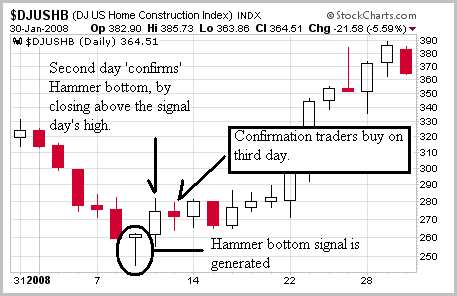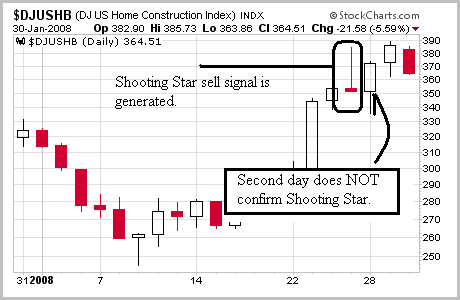How to Confirm Buy and Sell Signals With Candlesticks
I hate to say it, but charts lie…at least, they try to anyway. Zeroing in,
I’m specifically referring to buy and sell signals derived from candlestick
charts and how they can lie to us, if used without confirmation.
Before I get to far though, here’s a quick history of candlesticks, for those
who aren’t familiar with the charting style. Back in the 1600’s the Japanese
developed candlestick charting to map rice futures. The Japanese were
insightful enough to see that if they were to visually map out price action,
certain patterns developed time and time again. Then, in the 1700’s a man named
Hommo began to delve into the theoretical understanding of
how price action is actually a derivative of emotion. And for the most
part, candlestick charting has been the same ever since.
The Six Core Principals of Technical Analysis
Charting, like all technical analysis, must be understood for what it is.
The core principals to understanding what technical analysis is and why it is
important are:
1. Charting and technical analysis are lagging indicators, meaning that they
display information about an event that has already occurred.
2. Using technical analysis alone, without regard to fundamentals, or news is
lazy, and will often cause losses.
3. Technical analysis should be used as a “beacon in the night”, signaling
that an event, or shift (fundamental, or news-oriented) within the market, or
stock has occurred.
4. Often, technical analysis relies on ‘self fulfilling prophecies’, meaning
that many people must be watching, believe in, and act on the same data for
signals be accurate.
5. There is no ‘secret code’ to the market. Some technical signals work
better than others, but none will work “all of the time.”
6. Traders who use technical analysis (while also paying attention to
fundamentals and news too), but fail to use simple ‘common sense’, will
eventually get killed.
A deep understanding of the above principals is vital to trading with
technical analysis, and candlestick charting. One must understand technicals
for what they are, while keeping a clear head about the signals that come about.
However, the buy and sell signals can be misleading…
It is crucial to know confirmation is essential when attempting to trade on
candlestick charting patterns and signals.
Just FYI: I’m not going to spend time on how candlestick charting is done, or
the actual patterns and signals themselves. For this article, I am assuming
readers have a working knowledge of candlestick charting.
Confirmation is the Key
Getting to the meat of the article, candlestick charting can often produce a
significant amount of ‘false signals’, especially during times of high
volatility. And thus, traders who are really looking for an edge, or at least,
hope to minimize being wiggled out of new positions could very well see dramatic
results in their trading by ‘waiting for confirmation.’
When I say confirmation, what I mean is waiting for the second day, following
the signal day, to prove the move.
In other words, if a sell signal is given, traders who wait for confirmation,
would take the trade on the third day, after the signal was created (day one),
only if the day following the signal (day two), the instrument in question,
closed below the signal day’s low.
The below chart give a specific example of ‘confirmation.’ In January of
this year, the U.S. Dow Jones Housing Index (DJUSHB) put in a major bottom
signal called a Hammer. The signal is widely accepted as alluding to a pending
reversal (the opposite of a Hammer bottom would be a Hangman top.)

In the DJUSHB chart, we see where the chart clearly displays a hammer
bottom…something candlestick enthusiasts were salivating over at the time.
However, instead of immediate taking positions on the second day, confirmation
traders would have waited until the third day, thus making the pattern ‘prove
itself’, by putting in a second day close above the signal day’s high.
Confirmation traders would have taken positions on the third day…and would
have likely profited handsomely since.
There are ‘Four Corners of Confirmation’ that must be addressed at this
point.
1. Waiting for confirmation takes patience…and can sometimes lead to
missing a trade.
2. Missed money is always better than lost money. Even if waiting for
confirmation means letting an opportunity slip by, it’s a whole lot better than
jumping the gun into a losing trade.
3. Confirmation does not mean a trade is a sure thing. Pre-determined stops
are vital to profitable trading and effective money management.
4. Even with confirmation, more work is required. Traders must take the time
to research underlying fundamentals and news with every signal generated.
Trading blindly on technicals is just plain stupid.
Here’s what it all really comes down to, waiting for confirmation can save
you money and potentially increase your profitability.Why?
When a signal is ‘confirmed’, the market is saying Wall Street believes in
the signal and a trend is likely to ensue.And that’s what it all really comes
down to…knowing that a signal is more than volatility, something that happens
all too often in today’s market.
I want to now take a moment to show you a chart where the ‘signal’ lied, and
traders who jumped the gun, probably may be losing.
The Fake Out
Remember the chart of the DJUSHB that we just looked at? Just a few sessions
ago, the chart generated Shooting Star sell signal, something that is usually
fairly indicative of a top. However, on the following day, the trading action
in the DJUSHB did not confirm the signal from the previous session, as the index
closed near above the previous day’s high. Moreover, in the following session,
the DJUSHB even closed above the high of the confirmation day, which probably
would have stopped most risk-adverse traders out.
While it’s still yet to be seen whether the DJUSHB will fade from recent
gains, the Shooting Star sell (short) signal was probably misleading for most
swing traders.

Those who had already established long positions and were waiting for
sell-signal confirmation are up even more in their trade. (Just FYI, these
individuals would probably benefit from a trailing stop at this point, but
that’s another article in itself).
On the other hand, investors and traders who took short positions on the
Shooting Star day and did not wait for confirmation, have likely already closed
their trades for a loss…at least, if they have solid money management skills,
anyway.
Confirmation traders, however, would have never taken a position at all, and
would most likely be very happy that they didn’t, as of now.
At the end of the day, waiting for confirmation is just good housekeeping, at
least when trading from candlestick chart-derived signals.
Exit is everything.
Mark Whistler is the founder of
WallStreetRockStar.com and is the
author of multiple books on trading.
Mark’s newest book, The Swing Trader’s Bible (John Wiley & Sons, Inc.) –
co-authored with CNBC/Fox News regular guest Matt McCall – will be on shelves in
late summer, 2008.
In addition, Mark also writes regularly for TraderDaily.comand Investopedia.com.
